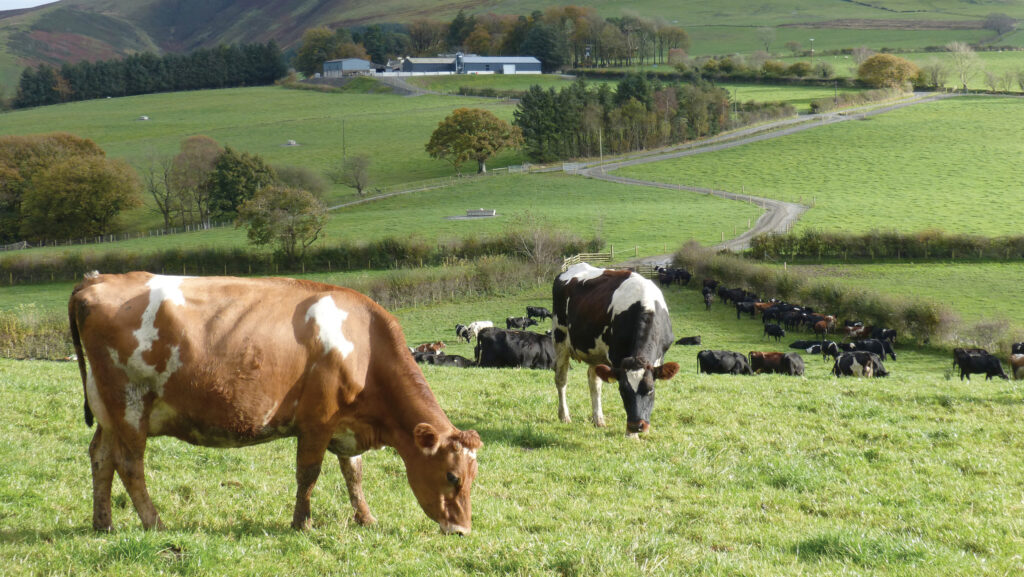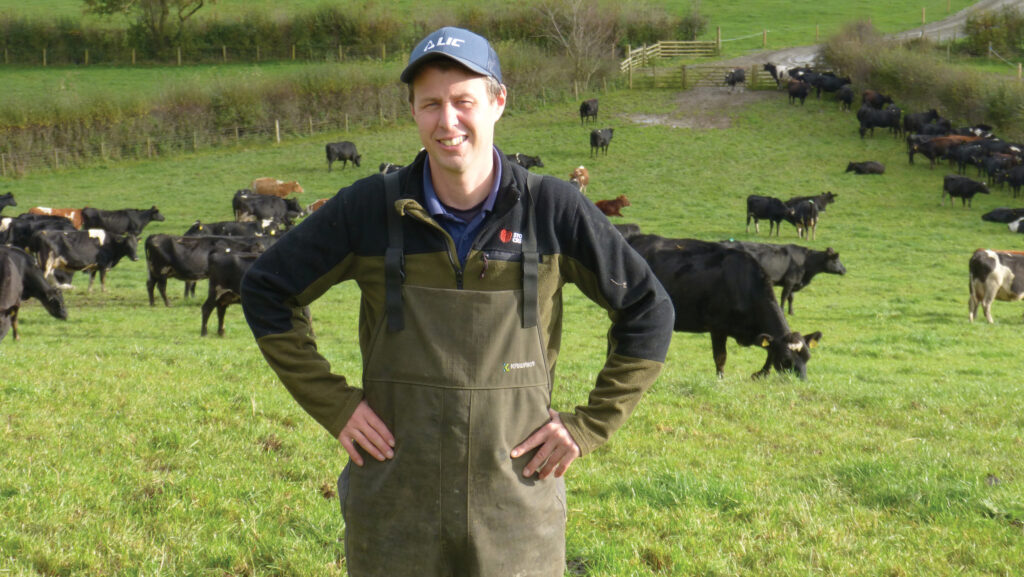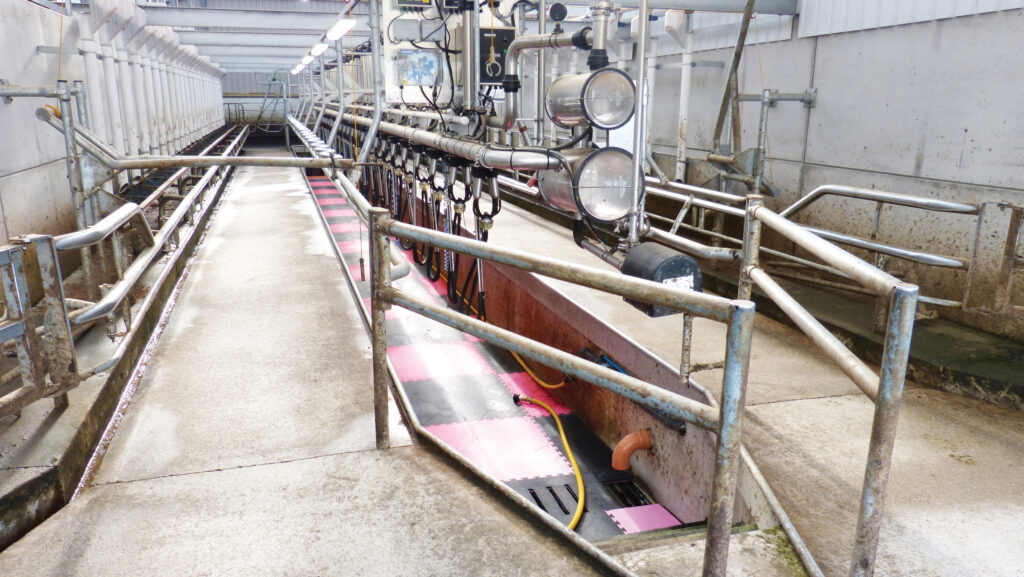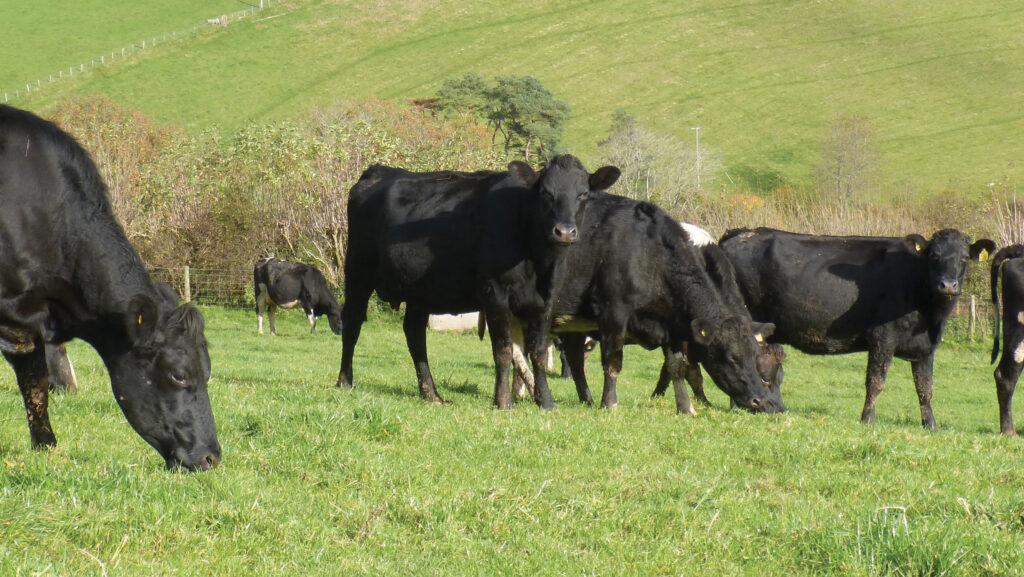Heifer rearing launch pad gets new entrant dairying
 © MAG/Michael Priestley
© MAG/Michael Priestley Rhidian Glyn had done one milking in his life before he started dairy farming in his own right last spring.
However, he had 10 years’ experience of heifer rearing, silage production, and rotational grazing on his tenanted farm Rhiwgriafol, near Machynlleth, Powys.
See also: Equity partnership propels pig farmer’s son into dairying
Rhidian started farming at Rhiwgriafol in 2014, while still working as a full-time feed rep.
He contract-reared 30 dairy heifers and bought 880 ewes from the landlord. He borrowed £100,000 to fund this, which was paid off in nine years.

Rhidian Glyn © MAG/Michael Priestley
However, dairying was an attractive goal to Rhidian due to the potential for greater returns. Both his grandfathers milked cows, so he says it was in his blood.
His milk production system now requires three full-time labour units, and, thanks to understanding lenders and suppliers, survived losing three weeks’ milk cheque in May.
Farm Facts
Rhiwgriafol farm, Machynlleth, Powys
- Friesian cross Jersey herd
- 10-week spring calving block
- 4,200 litres a cow in 2024
- All ground is rented
- 89ha grazing platform
- 55ha support ground next door
- 65ha five miles away for sheep, silage and youngstock
- 120ha hill ground for sheep
- Breeding done by LIC – 88% six-week in-calf rate and 6% empty
Farmers Weekly asked Rhidian what steps he took to start dairy farming.
1. Contacts and people
Rhidian says good relationships with other farmers has been essential.
His motto is “talk to good farmers – learn from their mistakes”. This is what he did:
- Developed a learning network, including people at Aberystwyth University and Young Farmers’ Clubs. He spent 10 years as Bro Ddyfi Grassland Society secretary, and 11 as a ForFarmers feed rep
- Learned farm office skills on a farming Connect Agri Academy course in 2013 with fellow new entrant dairy farmer Elgan Davies, who paid him to rear heifers
- Twitter (now X) connected Rhidian with dairy farmers further afield to grow his heifer rearing enterprise
- Used local engineer and friend GT Davies undertook to carry out infrastructure work
- Took on neighbouring farmers Eifion Pughe and Fflur Jones, who have proved to be skilful and dependable employees
- Rhidian had a day’s “crash course” in milking, calving and colostrum management with spring calver Newton-based Nick Davis in 2023
2. Know your figures
Grass measuring, performance and financial figures have informed decisions.
Rhidian’s wife, Elen, is an accountant and Rhidian records all output, costs, prices and margins in Microsoft Excel.
Because he knew his costs, Rhidian always kept his shop window full, selling bulling and in-calf heifers, calves, breeding lambs, ewes and in-lamb ewes for cashflow.
Lambing outdoors, performance recording and using performance-recorded Aberfields created a market and premium for buyers seeking breeding sheep with figures and kept costs down.
3. Build capital/assets
In 2015, Rhidian’s light hill lambs averaged £53, earning £318/ha (1.25 lambs a ewe). He knew he needed a more lucrative enterprise to grow his balance sheet and develop the business.
Rhidian contract-reared 30 heifers for Elgan Davies – his Agri Academy course contact – and reared for other farms. The risk was the farm failing a TB test and being locked down with in-calf heifers to house and feed.
Heifers were delivered at three to four months and returned in-calf at 18-20 months. Owners paid haulage and medicine costs. Within five years he had 380 R1s (yearling heifers) and 380 R2s at peak summer stocking.
Calves had one three- to four-month winter on straw. Demand for his service was strong. Spring block-calving entrants wanted to dilute new parlour fixed costs by outsourcing heifer rearing and maximising milker numbers.
A flat rate of £1/day was charged a head. Elgan’s 30 heifers strip grazed on 5.7ha (14 acres) and had 2.4ha (6 acres) of silage, bringing in £1,060/ha more than the sheep in 2014. This allowed Rhidian to bank more money.
4. Invest in key infrastructure
This cash was invested in a shed (for £50,000) and slurry store (£20,000) in 2020, doubling winter housing capacity to 280 cattle (a further 100 were housed on other farms).
This had two strategic benefits. First, it increased the farm’s earning capacity as more heifers could be wintered.
Second, the shed’s scale could house a three-row, 120-cubicle conversion for dairy cows, meaning half the building requirement for a higher profit dairy business was complete.
5. Conversion to dairy
Once experienced at heifer rearing, Rhidian started buying and trading heifer calves privately.
Calves typically cost £100 and could be sold in-calf for £900 (earning £1.48 a day).This gave him a launchpad for a dairy business.
Owning heifers meant Rhidian’s livestock valuation was about £600,000, and he had the heifers to start a herd if the chance arose.
Fledgling cheese processor Mona Dairy was seeking block calvers and agreed a contract in November 2022. Rhidian also sounded out Yew Tree Dairy to keep his options open.
The dairying proposal was sent to the landlord, who agreed and extended the tenancy for 15 years (Rhidian was 38 at the time).
About £300,000 was raised by selling 200 surplus heifers, the year’s lamb crop, 400 ewes and £13,000-worth of rams. This helped fund groundworks and infrastructure.
A loan was needed to fund the rest of the project. Rhidian showed the bank he had run a successful grazing business to pay a loan off and fund the building of a shed.
Oxbury bank lent him £250,000 over 15 years at 3.2% over base in an unsecured loan in January 2024.
The deal is interest-only for the first two years, and for the two months the herd is dry each year. Groundwork started in May 2023, costing £40,000.
A parlour area was levelled and 1.6km of tracks laid with farm-quarried stone. Paddocks were linked up to a water system, which included pipe connectors, tapping a spring and 25 water tanks, each 2,250 litres, for £40,000.
August 2023 saw the parlour building and collecting yard concreted, costing £255,000. A 24:48 Waikato parlour was installed with automatic cluster removal for £135,000, with 16,000-litre Fabdec milk tank at £44,000.
Once handling facilities were installed for £10,000, the dairy was ready to go, taking the total spend to £525,000.

© MAG/Michael Priestley

© MAG/Michael Priestley
Shaky start
However, Mona Dairy went bust, just two months into milk production.
The farm lost £42,000 of income and £40,000 due to change of payments terms.
“Fortunately, fertiliser had already been bought,” says Rhidian.
“But we had to very carefully cashflow the business. We went from spending £2,000 a month to just buying dog food.
“Luckily, Yew Tree Dairy – now owned by Muller – offered us a contract we signed. No milk was discarded, and the bank was kept up to speed with everything.”
Future
By the winter of 2025-26 the cows will be housed in cubicles, rather than loose housed on straw, which cost £27,000 this winter at £120/t delivered.
A new 120-cubicle shed will be erected and the shed Rhidian built will have 120 cubicles installed.
Rhidian hopes to retain heifers to hit 300 cows by 2026. As the herd matures, he aims to reduce cake rates (4kg peak in 2024) from 1t a cow.
A final project is to finish tracks to the grazing platform as 40% are not linked yet.
